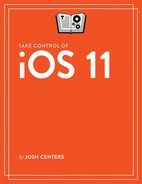Improve Battery Life
Keeping mobile devices powered is a persistent challenge. As iOS tries to do more and more for you, features like background tasks, Location Services, iCloud syncing, and Background App Refresh can strain a battery. Fortunately, iOS offers some tools that can extend your battery life.
Tame Battery Usage
In Settings > Battery, under Battery Usage, apps are sorted by how much power they’ve used, but apps near the top aren’t necessarily wasteful. If you use an app often, it will naturally use more battery.
Apps with the Background Activity label are using a lot of power in the background. In some cases, this is okay. For instance, I want Mail to run in the background so it can notify me of new messages. However, if an app (like Facebook) is draining a lot of battery in the background, consider disabling its background refresh and Location Services.
Go to Settings > General > Background App Refresh to turn off background refresh on a per-app basis—or get rid of it completely by turning off the Background App Refresh switch.
To turn off Location Services on a per app basis, tap Settings > Privacy > Location Services and disable location sharing for those apps you don’t want wasting power tracking you. You can also set an app to track you only while you are using it.
Find Out if Your Battery Is Draining
It can be difficult to tell whether a battery is draining normally or a particular app is being an energy hog. Here’s the definitive way to find out:
- Charge your battery to 100 percent and unplug your device.
- Put your device to sleep and don’t use it for an extended period—overnight is a good time for this test.
- In the morning, go to Settings > Battery.
- Under Time Since Last Full Charge, at the bottom, check the Usage and Standby time. If you haven’t used the device since charging it, but the Usage time is close to the Standby time, then an app is preventing the device from sleeping soundly.
If you think an app is the culprit, look for apps with the Background Activity label in the Battery Usage screen.
Turn Down the Brightness
An iOS device’s display is one of the most significant drains on the battery, so you want to keep the screen only as bright as is necessary for comfortable use.
Adjust brightness with the Brightness slider of Control Center. Generally, you can get away with a lower brightness setting while in a dark environment, but brighter situations, such as direct sunlight, call for more brightness.
The Auto-Brightness switch in Settings > General > Accessibility > Display Accommodations can help manage this for you, making adjustments depending on ambient light levels.
Shut Off Radios
The radios in your device eat power:
- Bluetooth: Keeping Bluetooth enabled when you’re not using it can use battery power unnecessarily.
- Cellular: If your device has a voice or data plan, it’s a good idea to disable the cellular radio when you have poor connectivity. Otherwise, the device will constantly strain to find a signal, consuming a lot of power while doing so.
- Wi-Fi: If you’re desperate to improve battery life, you can turn off Wi-Fi. However, if your device has a bandwidth cap, Apple recommends that you leave Wi-Fi on to ensure that your device connects to the internet over Wi-Fi when possible.
Control Center lets you turn all of these off and on quickly (see Networking Platter). Or, turn them all off by enabling Airplane mode—tap the Airplane Mode ![]() button in Control Center.
button in Control Center.
Use Low Power Mode
Available only for the iPhone, Low Power mode disables certain services in exchange for adding hours to battery life. iOS prompts you to enable Low Power mode when your iPhone’s battery charge falls to 20 percent (and then again at 10 percent, if you ignored the first prompt). iOS disables Low Power mode automatically once the charge reaches 80 percent.
You can also enable or disable Low Power mode at any time in Control Center or Settings > Battery.
With Low Power mode on, the following features will not work:
- Automatic downloads
- Background App Refresh
- Mail fetch
- iCloud sync
- Some visual effects
Busting Battery Usage Myths
There are many myths surrounding battery life. Let’s take a look at the two most prevalent:
You Should Kill Background Apps
Many people recommend closing background apps that aren’t in use, but according to former Apple Genius Scotty Loveless, that can make the problem worse. The reason is that when an app is “open” in the background, it’s still present in RAM but not consuming any CPU or battery power. If you close that app, it will consume more battery power when you launch it again. So you shouldn’t “kill” background apps in the App Switcher indiscriminately. But…
If an app is using a lot of battery power unnecessarily, it’s a good idea to close it in the App Switcher—see Switch Apps on the iPhone.
You Should/Shouldn’t Overcharge
Modern device batteries don’t have problems with over- or under-charging. However, every battery has a limited life span, as defined by complete charge and recharge cycles. So, when an Apple device is charged to 100 percent, you should unplug it and use it until it drops to about 20 percent, then recharge it. It’s not a good idea to frequently use a battery until it runs out of power.
